Header Icons Icons Used In The Header
The white bar across the top of the screen and its icons are referred to as the app’s Header.
The icons here are global navigation buttons that persist across all pages.
-
My List
The full list of Patients assigned to my Teams, tap here to return to the list of clients. -
Group Chat
Read and write messages with other Team members, highlighted in blue when there are unread messages. -
Import Patient
This feature may not be activated for your version of CHAI, tap here to begin the process of importing a Patient from an external record. -
Batch Countersign
Only used if countersigning is required. This allows Trainee Users to contribute but their edits are not confirmed until a Full User contersigns them. This feature may not be activated for your version of CHAI.

Account & Password Management
Use this shortcut to change your password.Sign Out
Clicking this icon will sign your user out of CHAI and return you to the login screen.
Banner Icons Used to display information and aid navigation for
a specific individual

Each client assigned to your team will be represented by a banner in your list, it provides a condensed view of their personal details and the status of their tasks.
Whilst you are in the list, tapping anywhere on their banner will take you to the person’s Summary Page .
On the far left, you will see their Personal Icon , a stick-figure that reflects their mobility which was assessed in the Personal Details form. The border indicates the most recent Wellbeing Status, see below for a more detailed break-down.
On the right hand side you will see the Status & Shortcut Icons.
Client Mobility Icons Used in the Personal Icon
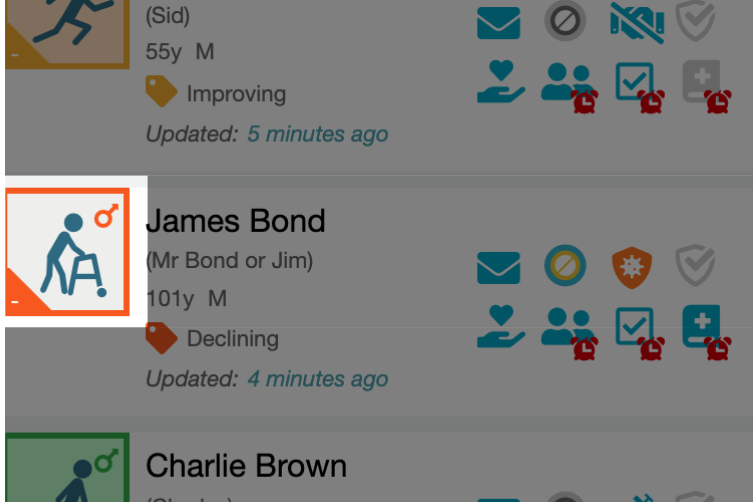
 Independent without aids
Independent without aids
People who have a range of abilities, from being able to partake in exercise or are very active occasionally (e.g. seasonally) through to people who may have medical problems that are well controlled, but are not regularly active beyond routine walking. Independent with a stick
Independent with a stick
While not necessarily dependent on others for daily help, often symptoms may limit activities. A common complaint is being “slowed up”, and/or being tired during the day. Independent with a frame
Independent with a frame
These people often have more evident slowing, and need help in high order IADLs (finances, transportation, heavy housework, medications). Progressively impaired ability to complete some tasks such as shopping and walking outside alone, meal preparation and housework.
 Independent with wheel chair
Independent with wheel chair
People who may have difficulty with some activities such as traversing stairs but are otherwise independent and able complete most tasks. Wheel chair with assistance
Wheel chair with assistance
People who need help with all outside activities and with keeping house. Inside, they often have problems with stairs and need help with bathing and might need minimal assistance with dressing. Immobile
Immobile
Completely dependent and require assistance to complete many tasks indoors and outdoors.
Wellbeing Colour Code Personal Icon Border and the Wellbeing Tag in the Banner
The coloured border around the Personal Icon in the Banner indicates the Client’s Personal Wellbeing Status that was last entered in the Contact Log .
This uses a traffic-light colour scheme to indicate at-a-glance how they’re doing, where pale green is the most positive state, whereas a dark red border is reserved for the most serious concern.
In addition to the coloured border, their wellbeing is also indicated in the text that is displayed alongside the matching tag in the banner.
1. No obvious concern
Physically & mentally okay.2. No obvious concern but socially isolated
Signpost local support.3. Becoming a concern
Advise individual to seek professional help.4. A concern but improving
Possibly as a result of professional help.5. A concern & declining
Ask if professional help is being provided.6. A concern & declining
Professional help needed.
Shortcut & Status Icons See important information at a glance in the Banner, tap to jump straight to the right place
Active Icons
Icons in this area that are highlighted in blue indicate that one or more forms in this area are due or otherwise require attention.
Unread Notes Shortcut
Clicking on this takes you to the notes in the person’s dashboard where you can attach files, record audio, text, pictures, create tasks and save memos.
 Person with Allergies Shortcut
Person with Allergies Shortcut
When highlighted, it lets you know that this person has an allergy. Their allergies will be briefly listed at the head of the person’s dashboard, tap on the shortcut to see the extended details.
Countersigning
This icon indicates that this person has forms entries that need to be countersigned, your group may not be using this feature.
Contact Log
This takes you to the form that should be completed for each contact regarding this client and allows you to note this person’s overall wellbeing, general health and any assistance required.
Daily Assistance
This takes you to the full list of forms that help you to record helpful daily activities that you’ve completed, including the Contact Log and Shopping.
Tasks Due
In this person’s notes you are able to set tasks for all users, this shortcut will be highlighted when there are incomplete tasks. Clicking on it will take you to the notes, filtered to only display the tasks.
Active Health Diary
If the person has provided prior consent, there are a few forms that will guide you through how to help the person manage their chronic illnesses.
Inactive Icons
Icons become greyed out when forms are up to date and don’t require attention.
Clicking on them still takes you through to the relevant form. Icons in this area that are highlighted in blue indicate that one or more forms in this area are due or otherwise require attention.
Read Notes Shortcut
 Person with No Recorded Allergies Shortcut
Person with No Recorded Allergies Shortcut
No Countersigning
Contact Log is up to date
Daily Assistance is up to date
No Tasks are Due
Health Diary is up to date
Covid Status Icons and what they mean
The covid status of the household is shown with one of the following icons.
Shielding
An individual in this household is at high risk due to medical history or age.
Potentially Immune
This Patient may be immune, has tested positive for antibodies or has received a vaccine – check details
Quarantined
This household may have the virus – get them tested/traced.
Unknown
Their status has not been recorded yet.
Isolating
This household is observing social distancing.
Summary Menu Icons Access all of this person’s main forms
At the left-hand side of the Client’s Summary page the vertical list of icons is the Summary Menu, these are links that take you to the relevant parts of the Client’s forms.
Many of them are also in the Shortcut Icons in the Banner. It is simply down to personal preference which icons you use to get to the same place.
An orange bell attached to a menu item indicates that one of these forms is nearly due.
A red alarm clock attached to a menu item indicates that one of these forms is overdue.
Client Details
The collection of forms that contain general background information about the person that won’t be changing frequently, such as name, preferred language and medical history. This icon and the forms within will have a surrounding circle that indicates the completion level.
Contact Log
This takes you to the form that allows you to note this person’s overall wellbeing and general health.
Daily Assistance
This takes you to the full list of forms that help you to record helpful daily activities that you’ve completed, including the Contact Log and shopping.
Health Diary
If the person has provided prior consent, there are a few forms that will guide you through how to help the person manage their chronic illnesses.
Forms & PDFs
This contains both the entire collection of Client Detail forms as well as “Connect to Professionals” and “Covid-19” forms.
Concern or Help
If you have concerns about this person’s health and wellbeing, this external link to our Concerns page has guidance on what you can do to help.
Client Note Icons Write notes, attach files and create tasks
You are able to add notes to the client Summary Page by tapping inside the expanding text box above all of the notes. These attachment icons appear beneath the input box, tapping on them allows you to supplement your note with additional details.

Document Attachment
This opens your device’s native file navigator so that you can attach documents to your message. Accepted file formats are: .txt, .pdf, .doc
Audio Recording
This opens an audio recording panel, tap on the large Microphone Icon to begin recording your message and tap again to stop. You can always preview your message before it is submitted.
Image Attachment
Attaches images to your note by opening your device’s native image handling application where you can either take photographs directly with the camera or browse for existing images.
Tasks
Tap this to create a task in the person’s note with your chosen due date/time.
Note Filter IconsCut down the list of notes by type
In the client Summary Page , these icons appear directly above the list of notes. In the full patient notes page, the filter icons appear on the left-hand column.
Tapping on one of these icons will filter down the list of notes so that it only shows notes of that type. Tapping on a different icon, will include that type of note in the filtered list.
Tapping on a selected icon will remove that type of note from the filter. Alternatively, you can always tap on the “reset” button to remove all filters.
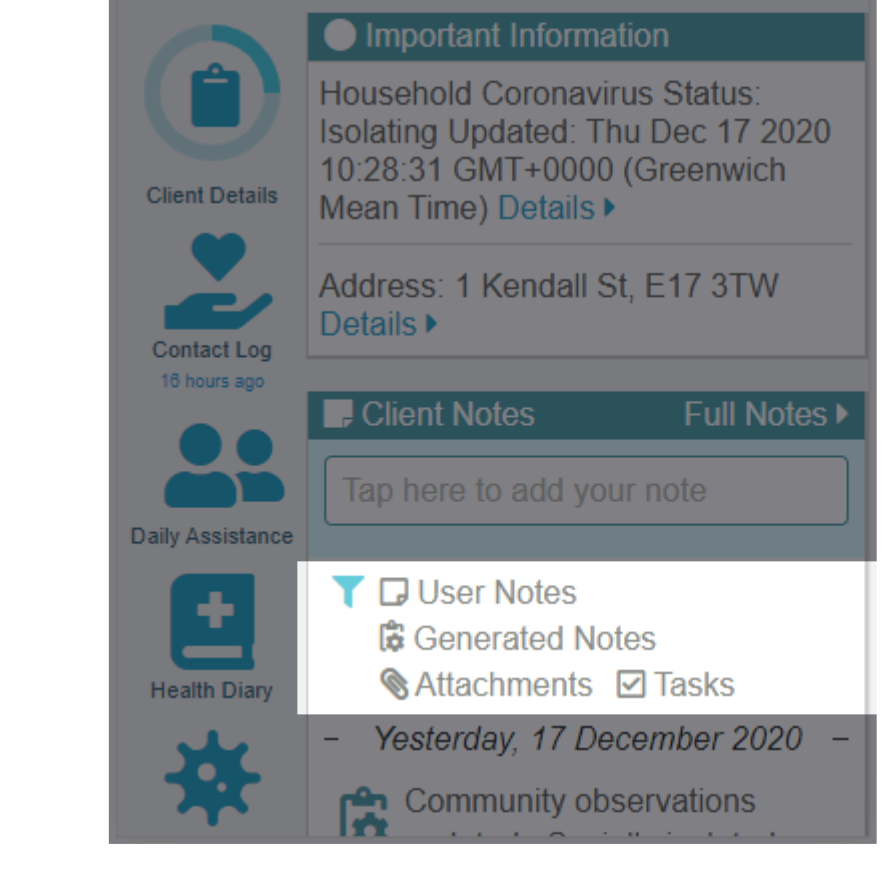
Written User Notes
This filters all of this person’s notes down to those that were manually written by users.
Generated Notes
Filters down to notes that are automatically generated by the system when forms are completed or important information is highlighted.
Document Attachment
This filters all of this person’s notes down to those that include attached audio, images or documents.
Tasks
This filters all of the notes down to incomplete and completed tasks.
